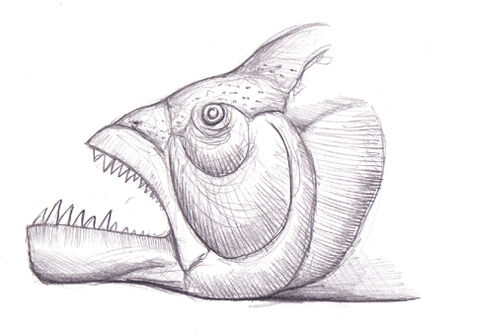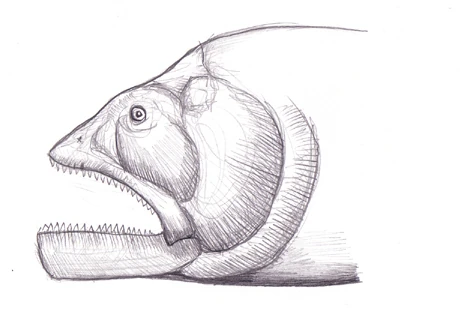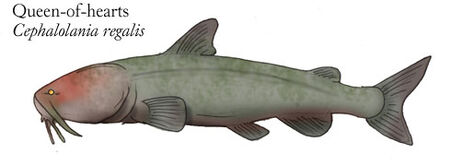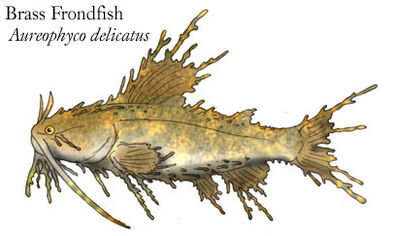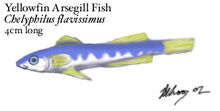Ray-finned fishes, especially the extraordinarily successful teleosts, make up the majority of the macroscopic life from ocean floors to mountain creeks. Most of Spec's fish life seems familiar, but a few examples are striking in their strangeness.
ELOPOCEPHALA[]
(Catfish, trout, etc.) You know... normal fish! Minus a few exceptions of some species of fish that are known to Spec Earth which can not be found back on homeworld. Examples being the Holy-Mackerel, fish that feed of the anus of the Aquatitan and countless other species that thrive in various bodies of water.
Holy Mackerel (p-Thunnus religiosa)[]
At first thought to be a joke, the Holy Mackerel was accidentally discovered in the Florida Keys by speccryptozoologist Erik Attaway, who had traveled to the Keys on (yet more) reported sightings of undescribed elasmosaurs. Endemic to the warm waters of the Florida Straits, the species is easily recognized by the gold-colored `halo' marking on top of it's head. Holy Mackerel can weigh up to 800 lbs and can be up to 5 feet long. The species comes to spawn in the Florida Keys, laying their eggs in the relative safety of the mangroves. Since their discovery, Holy Mackerel have become popular among spexplorers as a sport fish discovered in the Florida Keys by speccryptozoologist Erik Attaway, who had traveled to the Keys on (yet more) reported sightings of living elasmosaurs. Endemic to the warm waters of the Florida Straits, the species is easily recognized by the gold-colored `halo' marking on top of it's head. Holy Mackerel can weigh up to 800 lbs and can be up to 5 feet long. The species comes to spawn in the Florida Keys, laying their eggs in the relative safety of the mangroves. Since their discovery, Holy Mackerel have become popular among spexplorers as a sport fish.
ICHTHYODECTIDAE (Pugpike and heebyjeebs)[]
The ichthyodectids were nearly (possibly completely) obliterated by the K-Pg event in our own timeline. In Spec, they are still alive and well, represented by at least 65 species. This species is entirely marine in present-day Spec (though freshwater forms once existed). Most of these species are pelagic predators, though some are deep-sea forms. One of the most unusual genera, at least by standards of morphology, mimics Home-Earth's boxfish.
Pacific Squidhunter Pugpike (Procumbodon agilis) & Atlantic Squidhunter Pugpike (Procumbodon atlantis)[]
The Pacific squidhunter pugpike (Procumbodon agilis) is a 3-meter species that typifies the fast-swimming guild of pugpike. It hunts squid by pursuit all over the Pacific and Indian Oceans. Its closest known relative, the Atlantic squidhunter pugpike (Procumbodon atlantis), does the same in the Atlantic. In sum, these two species these two species can be found in nearshore and pelagic, tropical and cool water areas, basically anywhere squid occur.

(fig. 1) Top: Pacific squidhunter pugpike, Procumbodon agilis (Indian and Pacific Oceans). Bottom: Daggertooth pugpike, Diabolognathus horridus (Pacific).
Daggertooth Pugpike (Diablognathus horridus)[]
In contrast, the daggertooth pugpike (Diablognathus horridus) lurks for prey and catches it in a surge of speed. Found throughout the Pacific, the daggertooth pugpike is an opportunistic eater, attacking anything edible from other fish to young baleen-squid. this species also masters the crocodilian death roll which it uses to tear flesh off floating carcasses.
Common Pugpike (Abbriviognathichthys vulgaris)[]
At two meters in length, the common pugpike (Abbriviognathichthys vulgaris) fits into the pursuit guild of pug pikes, cruising fast in search of fish and squid. It has a reputation for cannibalism. Common pugpikes are found globally in nearshore and pelagic waters in practically any climate.
Atlantic Rocktooth Pugpike (Geodon atlanticus)[]
A nearshore eater of benthic shellfish, the Atlantic rocktooth pugpike (Geodon atlanticus) is a common sight off the Atlantic coasts of the Americas. At a length of three meters, it falls into the average size range for pugpike, and is a member of the lurking guild. A related species, the one-meter-long Australian rocktooth pugpike (Geodon australis), is a common sight in South Australian waters and is often associated with smoochers because it feeds mainly on echinoderms.
Malcontent Pugpikes (Malevolichthys sp.)[]
The largest pugpike species, commonly 10 meters long, are the malcontent pugpikes (Malevolichthys). Two species, nearly identical except for internal characteristics, are found on opposite sides of the Americas, the Pacific malcontent pugpike (M. pacificus) in the tropical pacific, and the Atlantic pugpike (M. atlanticus) in the tropical Atlantic. These gargantuan fish feed almost entirely on plankton, using both fine teeth and gill rakers to strain krill and coral spawn from the water.
Lange-Wapper (Anversichthys ogriceps)[]
The Lange-wapper (Anversichthys ogriceps) is a large lurking pugpike of the North Sea. Initially described after rumors that it swam upstream into Belgian canals, this fish was named after a legendary Antwerp ogre. However, the river-species proved to be a large catfish (the Orson, p-Silurus wellesi), but by then the name had stuck. The Lange-wapper can change color and pattern to hide better among rocks and sea weed, a feat achieved by chromatophore control. It normally awaits its fish prey before lunging out to engulf it, but it has been known to take young seabirds at the surface.
PACHYCORMIDAE[]
Known for their elongated, serrated and scythe-like pectoral fins, as well as a tendency to obtain huge sizes as, this group did not last past the K-Pg boundary in our timeline. In Spec, however, it is alive and well; though many of the large forms were lost at the end of the Eocene, giant forms have risen once again since the early Pliocene. Many members of this groups have an extended snout tip, sometimes to the extent of it being a swordlike structure. Their blade-like pectoral fins are not only important for high-speed turns in these tuna-like fish, but also act as weapons in some species, being utilized to stun smaller creatures in rapid "flyby" attacks.
PACHYCHALYBINAE (Sickle fish)[]
The (Pachychalybs pacificus) is the Spec equivalent of the Bryde's whale (the "predatory" rorqual). This huge teleost is a ram-feeder that attacks schools of small to medium-sized fish, catching them directly in a series of robust but numerous gill rakers, or stunning them with its swordlike pectoral fins and sweeping back to scoop up the wounded. The extended rostrum of this species is somewhat broader than in most pachycormids, forming something of a ram or shield for the face of the animal. This species reaches an impressive 9 meters in length, but reaches rather high sprinting speeds despite its size. The pectoral fins are occasionally used in defense, but are generally ineffective against very large targets, from which Pachychalybs maintains distance with rapid sprinting movements.
With a maximum length of 14.3 meters, the (Lenichthys atrox) is the reigning champion for largest extant teleost. Similar to the Middle Jurassic Leedsichthys (though significantly smaller), this giant is a devoted filter-feeder. It is uses an incredibly dense series of super-fine gill rakers to sieve plankton from the water. Found throughout the Indian and southern Pacific Oceans, this mighty creature still shows a rather blade-like pectoral fin structure, but they are no longer used as weapons.
PACHYCORMINAE[]
Although not as impressive in size as some other pachycormids, harvester fish (Messorichthys) are fearsome predators. These rather tuna-shaped fish have some of the most well-developed pectoral blades in the family, and are voracious predators of smaller fish and other aquatic vertebrates. There are four described species, ranging in adult size from 1 to 6 meters. All hunt in large schools, often with as many as 40 individuals. A school of Messorichthys will most often hunt by herding and slamming through large schools of smaller fish. On occasion, they will make passes at larger prey, rapidly sweeping by in small groups to make stunning, raking attacks. These fish are extremely rapid swimmers: Messorichthys ensis has been clocked doing 90 km/h sprints. The rostrum is extended as a very small sword in two of the species in this clade.
SILURIFORMES (Catfish)[]
This is a highly speciose group in both Spec and RL. There are a few unique lineages in Spec.
ANDINICTHYIDAE[]
Fitzgeralds (Gihugrungosilure mississippiensis)[]
This magnificent silure is not related to the European Orson. This is instead a member of an ancient catfish line long extinct on HE, the, Andinicthyidae. Most modern Spec andinicthyids are small nondescript catfish detrivores found in the Amazon basin and in the brackish estuaries of the Caribbean and the Gulf of Mexico. These giant fish are the only freshwater andinicthyids on the North American continent. Found in the Mississippi drainage and Great Lakes regions. The term Fitzgerald comes from their first collection in the great lakes, with a Gordon Lightfoot song playing in the background on the boat. The term has stuck, even though we now know that this fish is found throughout the larger water courses of eastern North America. Fitzgeralds average 4 to 5 meters in length, but truly gigantic specimens believed to reach almost 8 meters are occasionally seen.
One such fish caused a moment of excitement when it ingested a spec diver, only to promptly spit her out. Apparently rubber and the natural human reaction to a potential life-ending event of such a magnitude didn't agree with the huge fish. Encounters not quite as up close and personal have been quite frequent with a distinct Lake Erie population known as "Bessie beetles".They are so named for their giant heads reminiscent of Volkswagen beetles (a HE automobile) in dimensions. Because so much of Spec's western Lake Erie is quite shallow, just as in HE, the Bessie Fitzgeralds often show much of their dorsal surfaces above the waters as they cross broad, but very shallow sandbars miles in length and width from one deep pocket to another in the summer months.
GIGADENTADIDAE (Guillotine catfish)[]
This family is named for the huge, blade-like upper tooth plates located on the maxilla of species in this group. The jaws expand laterally a great deal to allow these plates to hinge downward. Couple with the standard teleost jaw arrangement, this dentition allows guillotine catfish to quickly engulf a section of their prey, then squeeze it up against the tooth plates to slice it apart. The name "guillotine" is a reference to the rare instance of decapitation by this feeding method. Species in this family inhabit both marine and brackish waters.
PHYTOMIMIDAE (Frondfish)[]
This catfish family has derived an extreme level of mimicry-based camouflage. The fleshy protrusions and filaments extending from their body, fins and head allow members of this group to mimic kelp and other macro algae. Most species ambush crustacean prey from the bottom of shallow water. All frondfish are marine.
Other siluriformes:[]
Dinocandiru, Dinocandiru burgess (Amazon Basin) (See Rectal Probe)
Bowelsucker, Aumatichthys armatus (Amazon Basin) (See Rectal Probe)
Other neopterygians:
Yellowfin arsegill fish, Chelyphilus flavissimus (Coastal Australia) (See Featherbotties)
Bigfang tetra, Characosphyraena snrkai (Amazon Basin) (See Rectal Probe)
Bungholio knifefish, Microgymnotus botoi (Amazon Basin) (See Rectal Probe)
Sabretooth wriggler, Vampyrogobius belli (Amazon Basin) (See Rectal Probe)
Crapdigger, Scatichthys chooi (Amazon Basin) (See Rectal Probe)
UNDANGUILLIDAE (Acid eels, Ripplefins, Sea Flags, and Trombone Fish)[]
In a world where passerines are absent, primates are catlike predators, and cephalopods are whales, it came as no surprise to biologists to find out that seahorses never evolved. Taking their place are a unique family of eels, known by the unwieldy name of Undanguillids - the ripplefins.
Ripplefins earned their name from their unique, derived morphology, which stretches the classic anguilliform "slippery eel" shape to the limits. The mouth is developed into a long, tubular rostrum, which is used to suck up tiny floating prey. The body is considerably shortened and quite compact for an eel, while the dorsal and anal fins are merged into a large fin on the back, tail, and belly. While seahorses use prehensile tails, ripplefins use their single fin to move or hover in one place, maintained by the constant rippling motion of the fin (hence the name). The closest HE has to this spectacular swimming is be the cuttlefish. When swimming normally, these fish can undulate their body like an eel to move faster.
Undanguillids range in size from 10mm to over 1 meter in length (the impressive Sydney ripplefin Undanguilla australis). Reproduction is similar as in other eels. Transparent, larval leptocephali are spawned in large numbers at sea, and grow by feeding on plankton. By the time they reach the glass-eel stage, the elvers are already shoaling in large schools. Finally, the survivors (after possible migrations of countless kilometers) settle down in their final, adult habitat.
Behaviorally, ripplefins are more gregarious and active than seahorses. More often than not, they are decked in brilliant colors. Even species not found on coral reefs tend to be brightly colored. The reason for this was not found out until the first spexplorer perished from eating ripplefin sushi - their blood is toxic. Ripplefin blood contains particularly violent toxins that are deadly to small and medium predators, and highly distasteful to large carnivores; as a result, they are usually left alone. Cooking does destroy the toxins, however.
Atlantic Acid Eel (Vitrioconger atlanticus)[]
Insight into undanguillid evolution was provided by the acid eels. Otherwise similar to normal eels, acid eels do exhibit several traits that place them firmly on the road to the ripplefins. The Atlantic acid eel (Vitrioconger atlanticus) superficially resembles a conger eel, but with a shortened body and more elongated, tubular snout. The fins are well developed, and the blood is considerably more venomous than that of other eels - all hallmarks of the undanguillids. From then on, the rest of the family can be traced.
Ripplefins (Undanguilla sp.) are the most common, widespread, and well-known of the family, essentially the seahorses of Spec. Found worldwide, they are diversified into a variety of niches and forms.
Lipstick Ripplefin (Undanguilla erythrobucca)[]

Lipstick Ripplefin, Undanguilla erythrobucca (Great Barrier Reef). All credit for the artwork goes to Sphenacodon.
More than 40 species are known, ranging from lipstick ripplefins (Undanguilla erythrobucca) with bright red markings on the mouth, to flame ripplefins (Undanguilla aquapyria) with bright orange and yellow blotches. Clown ripplefins (Undanguilla pagliaccii) have particularly striking black-and-white coloration.
Opal Ripplefin (Undanguilla iridus)[]

Opal Ripplefin, Undanguilla iridus (Great Barrier Reef) All credit for the artwork goes to Sphenacodon.
Opal ripplefins (Undanguilla iridus) supplement their blue-green color scheme with eye-catching iridescence.
Eyed Sea Flag (Aquascripta ocellata)[]

Eyed Sea Flag, Aquascripta ocellata (Great Barrier Reef) All credit for the artwork goes to Sphenacodon.
There are also sea flags (Aquascripta sp.) with even more developed fins and longer bodies than ripplefins. The tail is developed into a spectacular but fragile "flag" used for display. These would rank among the most conspicuous fish in the sea if it weren't for the ample toxins in their blood. Some, such as the eyed sea flag (Aquascripta ocellata), use the pattern on their flag to distract and ward off would-be predators.
Zebra Trombone Fish (Trombichthys monochromus)[]

Zebra Trombone Fish, Trombichthys monochromus (Great Barrier Reef) All credit for the artwork goes to Sphenacodon.
Bizarre, highly derived trombone fish (Trombichthys sp.), with "beaks" almost as long as their bodies, are certainly the oddest of all. Restricted to a handful of species, these rare beauties are at once incongruous and fascinating to see gliding over a reef. The largest of these is the zebra trombone fish (Trombichthys monochromus), a swimming zebra crossing.
True, scientists were not surprised to discover the beautiful ripplefins. But they were surprised when they discovered the fate of Spec's true seahorses...
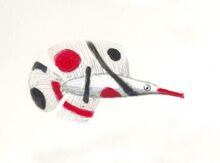
Miro ripplefin. All credit for the artwork goes to Sphenacodon.
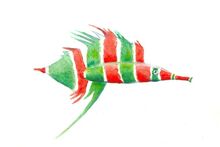
Flag ripplefin. All credit for the artwork goes to Sphenacodon.


